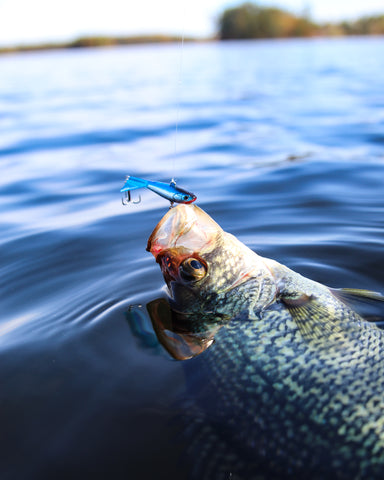
The Importance of Catch and Release
 Once thought of as an attitude of the bass, musky and trout anglers, catch and release is becoming a more common theme throughout all parts of the fishing community. Fishing purely for the fun of it, is a significant shift from the attitudes of our forefathers, who have historically spent their fishing time working to fill limits. In today’s world, there’s a growing segment of anglers that are more concerned with preserving catchable fish populations than filling a freezer with fillets. As fisherman, we should be thankful for that.
Once thought of as an attitude of the bass, musky and trout anglers, catch and release is becoming a more common theme throughout all parts of the fishing community. Fishing purely for the fun of it, is a significant shift from the attitudes of our forefathers, who have historically spent their fishing time working to fill limits. In today’s world, there’s a growing segment of anglers that are more concerned with preserving catchable fish populations than filling a freezer with fillets. As fisherman, we should be thankful for that.
While there is nothing wrong or illegal in keeping limits of fish, one should question whether or not mass quantities of fish removed from a lake is beneficial to the system itself. It is more important now, than ever before, that anglers realize how important certain fish are to the overall health of the fishery.
With every passing season, new rods, reels, boats, tackle, and electronics options hit the market – all of which are designed to make us more effective on the water. Technological advances in the fishing industry are leaps and bounds above where they were just a decade ago. Recent innovations have made finding and catching fish faster than it’s ever been.

In general, fishermen understand the importance of releasing trophy game fish. Fishermen can appreciate how important a 30-inch walleye or 50-inch musky is to a fishery. Additionally, most gamefish species have strict size limits that prevent large fish from being kept. That being said, it is still vital for anglers to recognize which fish are important to a given fishery. Keeping larger fish or large quantities of game fish, may have unfortunate consequences for a population as a whole. Fish managers typically work to protect certain year classes more than others, but often look for a balanced population.
While many anglers can grasp how important it is to release large walleyes, bass, or other gamefish, panfish, on the other hand, are of major concern. Unfortunately, panfish species, like crappies, bluegills, and perch, are often looked at as a readily renewable resource. It’s not uncommon for fishermen to keep limits of panfish night after night. Furthermore, anglers often underestimate the importance of large panfish, such as bluegills and crappies, and how their removal can negatively impact a fishery. Most areas of the country do not have size limits that protect larger panfish. It is often up to the discretion of the angler, and as a result can have some adverse effects. The removal of a few large bluegills or crappies from a population has the potential to be far more detrimental than removing a larger amount of small panfish. Catching trophy panfish is getting more and more difficult with each season.

If catch and release is important to you, there are some simple steps you can follow to ensure fish are released unharmed.
- Use the proper gear for the target species. You don’t want to end up in a high stakes poker game with a handful of pennies. If you plan to target larger fish, then make sure you’re properly equipped. The goal is the land the fish as quickly as possible and not leave them over exhausted.
- Keep the fish in the water as much as possible. Rely on nets, live wells, ice wells, or other tools to order to prevent the fish from being out of water too long.
- Wet your hands prior to handling the fish. This is a good practice for all fish species, but it’s particularly important with fish like trout. Handling fish with dry hands or gloves can remove their protective slime coating – and in turn, make them susceptible to harm.
- If necessary, cut your line. Often times you’re better off cutting the line on a deeply hooked fish rather than overhandling or causing damage just to get a hook out.
- If you plan to take pictures, have your camera gear handy. Don’t keep it stashed away, so you can’t access it quickly when you need it. You want to release the fish as quickly as possible.
- Last, but definitely not least, remember a gentle release. We’ve all seen way too many videos of fish being tossed in the air only to come down crashing on the water. Let’s change that.

Things are starting to change. As mentioned, attitudes surrounding catch and release are starting to shift for the better – and that’s great. Additionally, state agencies are modifying regulations year by year to protect important fish populations. In Minnesota, the Department of Natural Resources is doing great work with preserving trophy panfish populations by implementing lake specific size and quantity restrictions. These changes are ensuring that fish populations exist for future generations. We can only hope that other agencies across the Midwest, and United States, implement similar regulations. If you want to make a difference in your area, contact your local natural resources contact or legislator and let them know your concerns.
The importance of catch and release is real. It is vital that anglers as a whole work to preserve fish populations for future generations. On your next outing, take a moment to think about how keeping a given fish may impact a fishery over the long term. Remember – fishing isn’t just about filling a bucket.


SGT. ANDREW SMITH
Dear Eurotackle Company : Myself & other military personnels love your products . But for some reason we can’t ordered from your website because — when we click the " checkout " box , the website will not cycle through with our orders . All seven of us used our own phones & it does the same things .
Is there another way to order items from your company .
Thank you for reading our text .
Mark
Quite a compelling argument for catch and release. Makes logical sense. Any thoughts on hooking fish in the face, dragging them through the water and gently releasing them just for fun? You do know that fish feel pain right?
Mark
Quite a compelling argument for catch and release. Makes logical sense. Any thoughts on hooking fish in the face, dragging them through the water and gently releasing them just for fun? You do know that fish feel pain right?
Stan
Thanks for the timely and informative article. I fish here in Southern Nevada and I cringe at the practices of the majority of anglers when it comes to catching and releasing of our trout. They love to drag or swing the fish up onto the concrete shore or rocky shoreline and let the fish flop around until they reach down and grab it with a towel to unhook it. Then, it’s usually tossed through the air back into the water. Some don’t even leave the chair that they sit in while fishing the entire time. I do my part and do my best, and hopefully that makes a little difference. Happy fishing!
Theo
Love the blog. I do keep fish to eat, and not just load the freezer. Releasing big fish is very important. I’ll continue to spread the word.